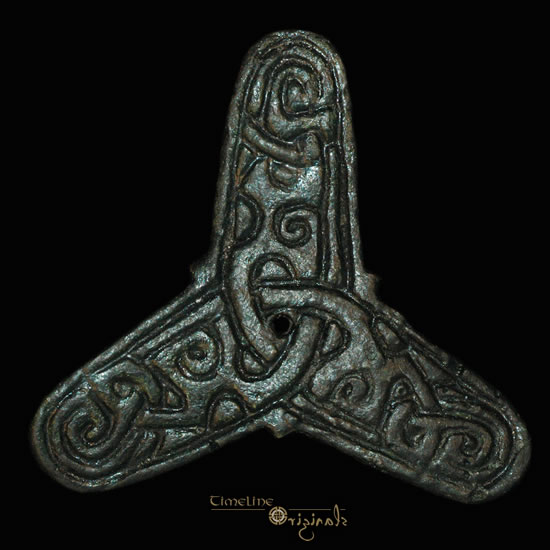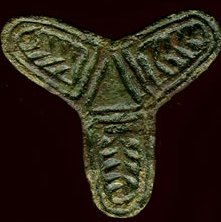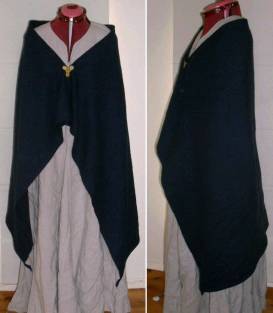Viking sword strap distributor
Although restored at one lug - wich only was becoming sharp to see when the strap devider was cleaned professionally - one of the cornerstones of my collection.. first considered to be a classic trefoil brooch.. Until.. Until I showed my example to the author of a new book I was reading - Viking identities - Scandiavian Jewellry in England -, Jane F. Kershaw. She immediately responded to me:
'The trefoil brooch is actually not a brooch but a strap-distributor, perhaps for a harness, of a type known from Iceland and Scotland. The projections at the side near the central plate show that the design comes from Carolingian baldric mounts, which have a similar shape. The central hole will have original held a rivet. The art style is not Ringerike, but Jellinge, although it seems to have been misunderstood in places. I'd place it in the first half of the 10thC.'
She also sended me an intruiging article on these kind of trefoil mounts/strap distributors.
In this article - hereunder attached - there from 1997 there are two examples known found at Hafurbjarnarstadir and Holl in Iceland and one known (part of) example of Jarlshof at the Shetland Isles (found 1956), and two examples found in 1996 in Skipton-on-Swale, near Thirsk, North Yorkshire and Ewerby, near Sleaford, Lincolnshire.
Viking trefoil brooch
Bronze, 8.50 grams; 38.53 mm. Circa late 9th - early 10th Century A.D. An extremely rare type of English Viking brooch (see ref.: a number of 43 in England is recorded until know) in an excellent state of preservation.
Most of these type of brooches are found as segments, broken due to choise of material or soil conditions.
This example has a very clear deep incised line decoration with a central triangle at the junction of the arms, with conventionalised plants derived from imported western European trefoil mounts These three tree-like objects form the outer decoration to form a spectacular design and an amazing piece of art. Complete with catch plate and perforated hinge plate on the reverse.
Found in Norfolk.
Ref.: Viking identities, Scandinavian Jewellry in England by Jane F. Kershaw (2013) page 79-91 Trefoil brooches, page 82-83 trefoil brooches with geometric decoration (Type G) Fig. 3.43
Image beneath: after the brooch had been cleaned professionally
Brooches of this type were used to fasten a cloak or shawl on the breast. The form is modelled on Carolingian trefoil fittings from sword-belts of the ninth century, presumably either seized by the Vikings in raids on the Continent, or perhaps obtained peacefully through trade or the exchange of gifts. The decoration, however, uses animal rather than plant motifs, a style with which the Vikings were familiar. Simpler versions appear to have been mass-produced.
See also my blog
The trefoil brooch, where did it came from?
My example is said to be found in York in 1976. The vendor where I bought it from, possibly sold another example - see image above - but cannot recall it in his memory (it has to be another example as the picture is different from mine example.
Apart from these 7 examples, I have seen a 8th on display in the National Museum of Iceland.
A 9th example is published (also as a trefoil brooch) in Benet's second edition Artefacts of England & the United Kingdom - current values (2003) page 315, item no.: V-07-0202.
Ironically - as mentioned in the article - the trefoil mount from Hafurbjarnarstadir, Iceland was from a pagan burial where it was clearly worn in typical Scandinavian fashion as a brooch, with textile surviving attached to the lugs on its back. But this must have been a so called secondary use form. The Icelandic example aslo had an additional perforation through one of its arms, wich may suggest that the trefoil was worn as a pendant at some stage.
Just under 10 known examples - to me at least ! - a rare kind and type of viking artefact..
But who's counting ?
Images and drawing from viking trefoil brooch or sword strap distributor in National Museum Iceland (August 2018). Photo's : author.
Well. I could have been with these stones until after dark, but as my wife wanted to travel on.. well.. I see you again, some day, hogback stones from Gosforth. And if you happen to be there one day, do not forget that monument on the outside...
Further on with the Cumbrian hogbacktour !
In - yes, luckily again in - St. Peter's church in Heysham, there is a truly beautiful hogback stone. The guide told us, it had been studyied by Thor Ewing, a writer, in 2000. in 'Understanding the Heysham hogback' A tenth century sculpted stone monument and its context (link), Thor Ewing tells in detail what he dicovered on the both sides of this hogback stone.
Just being brought in the church as late as the 1970's accompanied with some protest here and there among the church visitors, considered as being a token of old paganism, it had been remarkably nice preserved, and a lot of detail can be seen, still. Truly worthwile a visit.
I had a small debate with the guide in the church if the - zoomorphic, in my opinion - faces on the sides were lions (or hippo's). The guide doubted if the vikings could have known about lions. Well I guess so, concerning the runes on the Ancient Greek lion statue at the Arsenal, Venice. For example. Vikings did travel south..
But when he told me he was doubting the vikings 'discovered' (as the native inhabitants were of course, in the first place) America before Columbus, I decided to rest my case..
One has to know when to start and to end a conversation ..
Just discovered the book in a bookstore written by Geoff Holder - The guide to the mysterious Lake District, I knew there had to be another hogback stone in Lowther, St. Micheal's Church. With a promising image described in the text of 'a naval and a land-based force of shield-bearing vikings above a fish and what might be a coiled sea serpent. On the reverse is a row of female figures with snakes, possibly a representation of the hideous hag Hel'. Wow. If that did not sound as a true pagan promised land ..
Not complaing too much after all we have seen, this visit was the dissapointing one of them all. But if you wife states 'I am happy to have seen them' and I am answering 'Measuring is knowing' and the even more obligate verb 'handling 'if we did not see it at all, we wouldn't have known anything at all of how they were looking' the glass was again half full, at the last day of our journey..
The hogback stone appeared to be just being tolerated within the entrance segment part of the church. As something you never use anymore but you do not throw away - entirely. That sort of feeling emerged when seeing this hogback asylum seekers.. Bed, bath and bread, ás we say in Dutch, but no luxury at all and standing on some outcuts of wood, you would balance the table with at home..
Come on, St. Micheal's Church.. care a bit more of your 'children' !
This hogback stone was moved in the church in 1907. Hogback stones layed partially buried in the churchyard before it was dug up and moved into the church.
The promising depiction of a longship - as certainly can be seen after some studying - see http://vikingminds.co.uk/pages/longship
we have missed !
The stone itself is (157 x 50 x 30 cm) and very worn.
The hogback stones in Cumbria - very diverse in quality, but everyone worth a visit ! Especially on a gloomy day in late October ...
The churches to visit - see photos of resp. St. Andrew's church in Penrith, St. Mary's church in Gosforth, St. Peter's church in Heysham and St. Micheal's church in Lowther.
Did I miss out on another one in Cumbria ? Let me know !
In a next blog I will take you to four - still remaining utterly mysterious- statues 'guarding' the graveyard of St. Andrew's church in Dacre..
For the last blog of October 9th see this link.
References: (as always, links to where the books can be ordered are attached).
Edwards, B.J.N. Vikings in North West England - The artifacts (1998);
Emery, Gordon, CURIOUS CUMBRIA, The Lake District & Beyond: A celebration of Cumbria (2023)
Ewing, T. 'Understanding the Heysham hogback' A tenth century sculpted stone monument and its context ;
Hall, R. Viking Age archaeology in Britain and Ireland (first printed 1990, reprinted with amendments in 1995);
Holder, G. The guide to the mysterious Lake District (2009)
possibly also (as there within the part of Cumbria dealing with Carlisle, the Eden Valley, Barrow-in-Furness, Whitehaven and the west coast is being dealed with)
Holder, G. Paranormal Cumbria (2010)
http://vikingminds.co.uk/pages/longship



